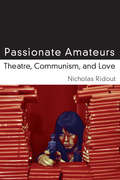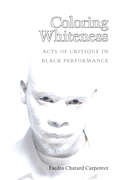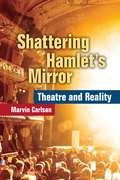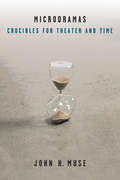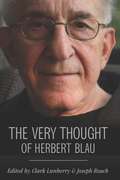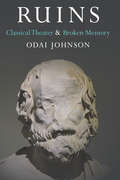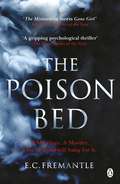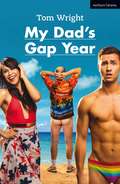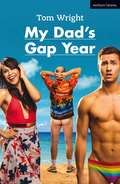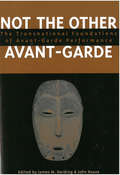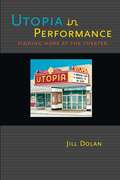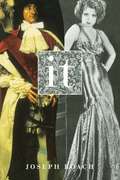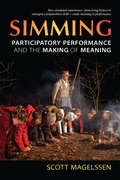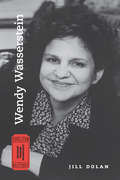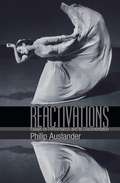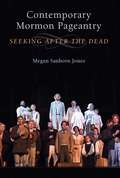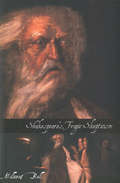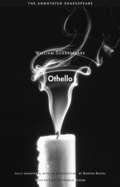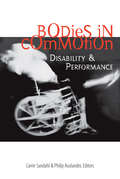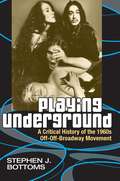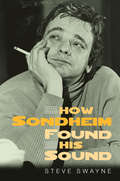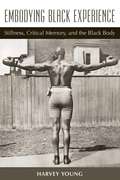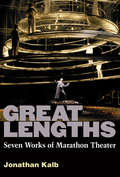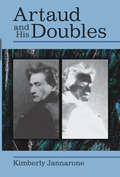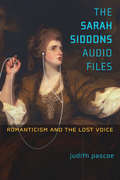- Table View
- List View
Passionate Amateurs: Theatre, Communism, and Love (Theater: Theory/Text/Performance)
by Nicholas RidoutPassionate Amateurstells a new story about modern theater: the story of a romantic attachment to theater’s potential to produce surprising experiences of human community. It begins with one of the first great plays of modern European theater—Chekhov’s Uncle Vanya in Moscow—and then crosses the 20th and 21st centuries to look at how its story plays out in Weimar Republic Berlin, in the Paris of the 1960s, and in a spectrum of contemporary performance in Europe and the United States. This is a work of historical materialist theater scholarship, which combines a materialism grounded in a socialist tradition of cultural studies with some of the insights developed in recent years by theorists of affect, and addresses some fundamental questions about the social function and political potential of theater within modern capitalism. Passionate Amateurs argues that theater in modern capitalism can help us think afresh about notions of work, time, and freedom. Its title concept is a theoretical and historical figure, someone whose work in theater is undertaken within capitalism, but motivated by a love that desires something different. In addition to its theoretical originality, it offers a significant new reading of a major Chekhov play, the most sustained scholarly engagement to date with Benjamin’s “Program for a Proletarian Children’s Theatre,” the first major consideration of Godard’s La chinoise as a “theatrical” work, and the first chapter-length discussion of the work of The Nature Theatre of Oklahoma, an American company rapidly gaining a profile in the European theater scene. Passionate Amateurscontributes to the development of theater and performance studies in a way that moves beyond debates over the differences between theater and performance in order to tell a powerful, historically grounded story about what theater and performance are for in the modern world.
Coloring Whiteness: Acts of Critique in Black Performance (Theater: Theory/Text/Performance)
by Faedra C CarpenterColoring Whiteness pays homage to the ways that African American artists and performers have interrogated tropes and mythologies of whiteness to reveal racial inequalities, focusing on comedy sketches, street theater, visual art, video, TV journalism, and voice-over work since 1964. By investigating enactments of whiteness—from the use of white makeup and suggestive masks, to literary motifs and cultural narratives regarding “white” characteristics and qualities—Faedra Chatard Carpenter explores how artists have challenged commonly held notions of racial identity. Through its layered study of expressive culture, her book considers how artistic and performance strategies are used to “color” whiteness and complicate blackness in our contemporary moment. Utilizing theories of performance and critical race studies, Coloring Whiteness is also propelled by Carpenter’s dramaturgical sensibilities. Her analysis of primary performance texts is informed not only by traditional print and visual materials, but also by her interviews with African American theater artists, visual artists, and cultural critics. The book is an invaluable contribution to the fields of theater and performance studies, African American studies, cultural studies, critical race studies, and American studies.
Shattering Hamlet's Mirror: Theatre and Reality
by Marvin CarlsonTheatrical playing, Hamlet famously averred, holds a mirror up to nature. But unlike the reflections in the mirror, the theater’s images are composed of real objects, most notably bodies, that have an independent existence outside the world of reflection. Throughout Western theater history there have been occasions when the reality behind the illusion was placed on display. In recent years theaters in Europe and North America have begun calling attention to the real in their work—presenting performers who did not create characters and who may not even have been actors, but who appeared on stage as themselves; texts created not by dramatic authors but drawn from real life; and real environments sometimes shared by actors and performers and containing real elements accessible to both. These practices, argues Marvin Carlson, constitute a major shift in the practical and phenomenological world of theater, and a turning away from mimesis, which has been at the heart of the theater since Aristotle. Shattering Hamlet's Mirror: Theatre and Reality examines recent and contemporary work by such groups as Rimini Protokoll, Societas Raffaelo Sanzio, the Gob Squad, Nature Theatre of Oklahoma, and Foundry Theatre, while revealing the deep antecedents of today’s theater, placing it in useful historical perspective. While many may consider it a post-postmodern phenomenon, the “theater of the real,” as it turns out, has very deep roots.
Microdramas: Crucibles for Theater and Time (Theater: Theory/Text/Performance)
by John H MuseIn Microdramas, John H. Muse argues that plays shorter than twenty minutes deserve sustained attention, and that brevity should be considered a distinct mode of theatrical practice. Focusing on artists for whom brevity became both a structural principle and a tool to investigate theater itself (August Strindberg, Maurice Maeterlinck, F. T. Marinetti, Samuel Beckett, Suzan-Lori Parks, and Caryl Churchill), the book explores four episodes in the history of very short theater, all characterized by the self-conscious embrace of brevity. The story moves from the birth of the modernist microdrama in French little theaters in the 1880s, to the explicit worship of speed in Italian Futurist synthetic theater, to Samuel Beckett’s often-misunderstood short plays, and finally to a range of contemporary playwrights whose long compilations of shorts offer a new take on momentary theater. Subjecting short plays to extended scrutiny upends assumptions about brief or minimal art, and about theatrical experience. The book shows that short performances often demand greater attention from audiences than plays that unfold more predictably. Microdramas put pressure on preconceptions about which aspects of theater might be fundamental and about what might qualify as an event. In the process, they suggest answers to crucial questions about time, spectatorship, and significance.
The Very Thought of Herbert Blau
by Clark Lunberry Joseph RoachHerbert Blau (1926–2013) was the most influential theater theorist, practitioner, and educator of his generation. He was the leading American interpreter of the works of Samuel Beckett and as a director was instrumental in introducing works of the European avant-garde to American audiences. He was also one of the most far-reaching and thoughtful American theorists of theater and performance, and author of influential books such as The Dubious Spectacle, The Audience, and Take Up the Bodies: Theater at the Vanishing Point. In The Very Thought of Herbert Blau, distinguished artists and scholars offer reflections on what made Blau's contributions so visionary, transformative, and unforgettable, and why his ideas endure in both seminar rooms and studios. The contributors, including Lee Breuer, Sue-Ellen Case, Gautam Dasgupta, Elin Diamond, S. E. Gontarski, Linda Gregerson, Martin Harries, Bill Irwin, Julia Jarcho, Anthony Kubiak, Daniel Listoe, Clark Lunberry, Bonnie Marranca, Peggy Phelan, Joseph Roach, Richard Schechner, Morton Subotnick, Julie Taymor, and Gregory Whitehead, respond to Blau's fierce and polymorphous intellect, his relentless drive and determination, and his audacity, his authority, to think, as he frequently insisted, "at the very nerve ends of thought."
Ruins: Classical Theater and Broken Memory (Theater: Theory/Text/Performance)
by Odai JohnsonMuch of the theater of antiquity is marked by erasures: missing origins, broken genres, fragments of plays, ruins of architecture, absented gods, remains of older practices imperfectly buried and ghosting through the civic productions that replaced them. Ruins: Classical Theater and Broken Memory traces the remains, the remembering, and the forgetting of performance traditions of classical theater. The book argues that it is only when we look back over the accumulation of small evidence over a thousand-year sweep of classical theater that the remarkable and unequaled endurance of the tradition emerges. In the absence of more evidence, Odai Johnson turns instead to the absence itself, pressing its most legible gaps into a narrative about scars, vanishings, erasures, and silence: all the breakages that constitute the ruins of antiquity. In ten wide-ranging case studies, theater history and performance theory are brought together to examine the texts, artifacts, and icons left behind, reading them in fresh ways to offer an elegantly written, extended meditation on “how the aesthetic of ruins offered a model for an ideal that dislodged and ultimately stood in for the historic.”
The Poison Bed: 'Gone Girl meets The Miniaturist'
by E C Fremantle'Warning: this book may well take over your summer. Think Gillian Flynn meets The Miniaturist' Waterstones______________London, 1615.Robert and Frances Carr are imprisoned, accused of murder.Their friend and confidante Thomas Overbury is dead.And they both have a motive for killing him . . . Frances, rescued from an abusive marriage, is determined to make a new life for herself . . . and will stop at nothing and no one to make sure she does.Robert is now one of the most powerful men in the land. But to get to the top he couldn't help but make enemies.One of them did it.But who? Because one of them will pay with their life.______________'A Jacobean GONE GIRL. Dark and deeply satisfying, a tale of monstrous intrigue and murder' M. J. Carter'A twisting psychological thriller based on a real Jacobean murder. Unputdownable' The Times
My Dad's Gap Year (Modern Plays)
by Tom WrightSeriously William, you're eighteen and you're gay, for Christ's sake. You're meant to swim against the tide. A proper gap year is all about traveling. Seeing the world. Popping your cherry. This is our chance to start living. Me and you.This is the story of Dave; a dad in mid-life freefall who takes his repressed, gay, teenage son William on a wild adventure to Thailand. Gay love, straight love, trans love, buddy-love, drinking games and beer bellies. Fasten your seat belts, it's gonna be a mad one!
My Dad's Gap Year (Modern Plays)
by Tom WrightSeriously William, you're eighteen and you're gay, for Christ's sake. You're meant to swim against the tide. A proper gap year is all about traveling. Seeing the world. Popping your cherry. This is our chance to start living. Me and you.This is the story of Dave; a dad in mid-life freefall who takes his repressed, gay, teenage son William on a wild adventure to Thailand. Gay love, straight love, trans love, buddy-love, drinking games and beer bellies. Fasten your seat belts, it's gonna be a mad one!
Not the Other Avant-Garde: The Transnational Foundations of Avant-Garde Performance (Theater: Theory/Text/Performance)
by James M. Harding John RouseAlmost without exception, studies of the avant-garde take for granted the premise that the influential experimental practices associated with the avant-garde began primarily as a European phenomenon that in turn spread around the world. These ten original essays, especially commissioned for Not the Other Avant-Garde, forge a radically new conception of the avant-garde by demonstrating the many ways in which the first- and second-wave avant-gardes were always already a transnational phenomenon, an amalgam of often contradictory performance traditions and practices developed in various cultural locations around the world, including Africa, the Middle East, Mexico, Argentina, India, and Japan. Essays from leading scholars and critics-including Marvin Carlson, Sudipto Chatterjee, John Conteh-Morgan, Peter Eckersall, Harry J. Elam Jr., Joachim Fiebach, David G. Goodman, Jean Graham-Jones, Hannah Higgins, and Adam Versényi-suggest collectively that the very concept of the avant-garde is possible only if conceptualized beyond the limitations of Eurocentric paradigms. Not the Other Avant-Garde is groundbreaking in both avant-garde studies and performance studies and will be a valuable contribution to the fields of theater studies, modernist studies, art history, literature, and music history. "Joins the growing field of critical and transnational theories on the arts. . . its grounding in live performance and its foregrounding of the performative human body presents a new theoretical paradigm that is pathbreaking." --Haiping Yan, University of California, Los Angeles James M. Harding is Associate Professor of English at Mary Washington University. He is author of Adorno and "A Writing of the Ruins": Essays on Modern Aesthetics and Anglo-American Literature and Culture and editor of Contours of the Theatrical Avant-Garde: Performance and Textuality. John Rouse is Associate Professor of Theater at the University of California, San Diego. He is author of Brecht and the West German Theatre.
Utopia in Performance: Finding Hope at the Theater
by Jill Dolan"Jill Dolan is the theatre's most astute critic, and this new book is perhaps her most important. Utopia in Performance argues with eloquence and insight how theatre makes a difference, and in the process demonstrates that scholarship matters, too. It is a book that readers will cherish and hold close as a personal favorite, and that scholars will cite for years to come." ---David Román, University of Southern California What is it about performance that draws people to sit and listen attentively in a theater, hoping to be moved and provoked, challenged and comforted? In Utopia in Performance, Jill Dolan traces the sense of visceral, emotional, and social connection that we experience at such times, connections that allow us to feel for a moment not what a better world might look like, but what it might feel like, and how that hopeful utopic sentiment might become motivation for social change. She traces these "utopian performatives" in a range of performances, including the solo performances of feminist artists Holly Hughes, Deb Margolin, and Peggy Shaw; multicharacter solo performances by Lily Tomlin, Danny Hoch, and Anna Deavere Smith; the slam poetry event Def Poetry Jam; The Laramie Project; Blanket, a performance by postmodern choreographer Ann Carlson; Metamorphoses by Mary Zimmerman; and Deborah Warner's production of Medea starring Fiona Shaw. While the book richly captures moments of "feeling utopia" found within specific performances, it also celebrates the broad potential that performance has to provide a forum for being human together; for feeling love, hope, and commonality in particular and historical (rather than universal and transcendent) ways.
It
by Joseph RoachA consumer’s guide to iconic celebrity and ageless glamour “Strikingly original, wickedly witty, and thoroughly learned, Roach’s anatomy of abnormally interesting people and the vicarious pleasure we take in our modern equivalents to gods and royals will captivate its readers from the first page. I dare you to read just one chapter!” —Felicity Nussbaum, University of California, Los Angeles “It considers the effect that arises when spectacularly compelling performers and cultural fantasy converge, as in the outpouring of public grief over the death of Princess Diana. . . . An important work of cultural history, full of metaphysical wit . . . It gives us a fresh vocabulary for interpreting how after-images endure in cultural memory.” —Andrew Sofer, Boston College “Joseph Roach’s enormous erudition, sharp wit, engaging style, and gift for finding the most telling historical detail or literary quote are here delightfully applied to the intriguing subject of why certain historical and theatrical figures have possessed a special power to fascinate their public.” —Marvin Carlson, Graduate Center, City University of New York That mysterious characteristic “It”—“the easily perceived but hard-to-define quality possessed by abnormally interesting people”—is the subject of Joseph Roach’s engrossing new book, which crisscrosses centuries and continents with a deep playfulness that entertains while it enlightens. Roach traces the origins of “It” back to the period following the Restoration, persuasively linking the sex appeal of today’s celebrity figures with the attraction of those who lived centuries before. The book includes guest appearances by King Charles II, Samuel Pepys, Flo Ziegfeld, Johnny Depp, Elinor Glyn, Clara Bow, the Second Duke of Buckingham, John Dryden, Michael Jackson, and Lady Diana, among others.
Simming: Participatory Performance and the Making of Meaning (Theater: Theory/Text/Performance)
by Scott MagelssenAt an ecopark in Mexico, tourists pretend to be illegal migrants, braving inhospitable terrain and the U.S. Border Patrol as they attempt to cross the border. At a living history museum in Indiana, daytime visitors return after dark to play fugitive slaves on the Underground Railroad. In the Mojave Desert, the U.S. Army simulates entire provinces of Iraq and Afghanistan, complete with bustling villages, insurgents, and Arabic-speaking townspeople, to train soldiers for deployment to the Middle East. At a nursing home, trainees put on fogged glasses and earplugs, thick bands around their finger joints, and sandbag harnesses to simulate the effects of aging and to gain empathy for their patients. These immersive environments in which spectator-participants engage in simulations of various kinds—or “simming”—are the subject of Scott Magelssen’s book. His book lays out the ways in which simming can provide efficacy and promote social change through affective, embodied testimony. Using methodology from theater history and performance studies (particularly as these fields intersect with cultural studies, communication, history, popular culture, and American studies), Magelssen explores the ways these representational practices produce, reify, or contest cultural and societal perceptions of identity.
Wendy Wasserstein (Michigan Modern Dramatists)
by Jill DolanPlaywright Wendy Wasserstein (1950–2006), author of The Heidi Chronicles, wrote topical, humorous plays addressing relationships among women and their families, taking the temperature of social moments from the 1960s onward to debate women’s rightful place in their professional and personal lives. The playwright’s popular plays continue to be produced on Broadway and in regional theaters around the country and the world. Wasserstein’s emergence as a popular dramatist in the 1970s paralleled the emergence of the second-wave feminist movement in the United States, a cultural context reflected in the themes of her plays. Yet while some of her comedies and witty dramas were wildly successful, packing theaters and winning awards, feminists of the era often felt that the plays did not go far enough. Wendy Wasserstein provides a critical introduction and a feminist reappraisal of the significant plays of one of the most famous contemporary American women playwrights. Following a biographical introduction, chapters address each of her important plays, situating Wasserstein’s work in the history of the US feminist movement and in a historical moment in which women artists continue to struggle for recognition.
Reactivations: Essays on Performance and Its Documentation
by Philip AuslanderMost people agree that witnessing a live performance is not the same as seeing it on screen; however, most of the performances we experience are in recorded forms. Some aver that the recorded form of a performance necessarily distorts it or betrays it, focusing on the relationship between the original event and its recorded versions. By contrast, Reactivations focuses on how the audience experiences the performance, as opposed to its documentation. How does a spectator access and experience a performance from its documentation? What is the value of performance documentation? The book treats performance documentation as a specific discursive use of media that arose in the middle of the 20th century alongside such forms of performance as the Happening and that is different, both discursively and as a practice, from traditional theater and dance photography. Philip Auslander explores the phenomenal relationship between the spectator who experiences the performance from the document and the document itself. The document is not merely a secondary iteration of the original event but a vehicle that gives us meaningful access to the performance itself as an artistic work.
Contemporary Mormon Pageantry: Seeking After the Dead
by Megan S JonesIn Contemporary Mormon Pageantry, theater scholar Megan Sanborn Jones looks at Mormon pageants, outdoor theatrical productions that celebrate church theology, reenact church history, and bring to life stories from the Book of Mormon. She examines four annual pageants in the United States-the Hill Cumorah Pageant in upstate New York, the Manti Pageant in Utah, the Nauvoo Pageant in Illinois, and the Mesa Easter Pageant in Arizona. The nature and extravagance of the pageants vary by location, with some live orchestras, dancing, and hundreds of costumed performers, mostly local church members. Based on deep historical research and enhanced by the author's interviews with pageant producers and cast members as well as the author's own experiences as a participant-observer, the book reveals the strategies by which these pageants resurrect the Mormon past on stage. Jones analyzes the place of the productions within the American theatrical landscape and draws connections between the Latter-day Saints theology of the redemption of the dead and Mormon pageantry in the three related sites of sacred space, participation, and spectatorship. Using a combination of religious and performance theory, Jones demonstrates that Mormon pageantry is a rich and complex site of engagement between theater, theology, and praxis that explores the saving power of performance.
Shakespeare’s Tragic Skepticism
by Ms. Millicent BellReaders of Shakespeare’s greatest tragedies have long noted the absence of readily explainable motivations for some of Shakespeare’s greatest characters: why does Hamlet delay his revenge for so long? Why does King Lear choose to renounce his power? Why is Othello so vulnerable to Iago’s malice? But while many critics have chosen to overlook these omissions or explain them away, Millicent Bell demonstrates that they are essential elements of Shakespeare’s philosophy of doubt. Examining the major tragedies, Millicent Bell reveals the persistent strain of philosophical skepticism. Like his contemporary, Montaigne, Shakespeare repeatedly calls attention to the essential unknowability of our world.In a period of social, political, and religious upheaval, uncertainty hovered over matters great and small-the succession of the crown, the death of loved ones from plague, the failure of a harvest. Tumultuous social conditions raised ultimate questions for Shakespeare, Bell argues, and ultimately provoked in him a skepticism which casts shadows of existential doubt over his greatest masterpieces.
Othello (The Annotated Shakespeare)
by William ShakespeareOne of the most powerful dramas ever written for the stage, Othello is a story of revenge, illusion, passion, mistrust, jealousy, and murder. If in Iago Shakespeare created the most compelling villain in Western literature, in Othello and Desdemona he gave us our most tragic and unforgettable lovers.
Bodies in Commotion: Disability and Performance (Corporealities: Discourses Of Disability)
by Carrie Sandahl Philip Auslander"A testament to the synergy of two evolving fields. From the study of staged performances to examinations of the performing body in everyday life, this book demonstrates the enormous profitability of moving beyond disability as metaphor. . . . It's a lesson that many of our cultural institutions desperately need to learn." -Martin F. Norden, University of Massachusetts-Amherst This groundbreaking collection imagines disabled bodies as "bodies in commotion"-bodies that dance across artistic and discursive boundaries, challenging our understanding of both disability and performance. In the book's essays, leading critics and artists explore topics that range from theater and dance to multi-media performance art, agit-prop, American Sign Language theater, and wheelchair sports. Bodies in Commotion is the first collection to consider the mutually interpretive qualities of these two emerging fields, producing a dynamic new resource for artists, activists, and scholars.
Playing Underground: A Critical History of the 1960s Off-Off-Broadway Movement (Theater: Theory/Text/Performance)
by Stephen J. Bottoms"Scrupulously researched, critically acute, and written with care, Playing Underground will become a classic account of an era of hard-won free expression." -William Coco "At last---a book documenting the beginnings of Off-Off Broadway theater. Playing Underground is an insightful, illuminating, and honest appraisal of this important period in American theater." -Rosalyn Drexler, author of Art Does (Not!) Exist and Occupational Hazard "An epic movie of an epic movement, Playing Underground is a book the world has waited for without knowing it. How precisely it captures the evolution of our revolution! I am amazed by the book's scope and scale, and I bless its author especially for giving two greats, Paul Foster and H. M. Koutoukas, their proper, polar places, and for memorializing such unjustly forgotten masterpieces as Irene Fornes's Molly's Dream and Jeff Weiss's A Funny Walk Home. Stephen Bottoms's vivid evocation of the grand adventure of Off-Off Broadway has woken and broken my heart. It is difficult to believe that he was not there alongside me to breathe the caffeine-nicotine-alkaloid-steeped air." -Robert Patrick, author of Kennedy's Children and Temple Slave Few books address the legendary age of 1960s off-off Broadway theater. Fortunately, Stephen Bottoms fills that gap with Playing Underground---the first comprehensive history of the roots of off-off Broadway. This is a theater whose legacy is still felt today: it was the launching pad for many leading contemporary theater artists, including Sam Shepard, Maria Irene Fornes, and others, and it was a pivotal influence on improv comedy and shows like Saturday Night Live. Off-off Broadway groups such as the Living Theatre, La Mama, and Caffe Cino captured the spirit of nontraditional theater with their edgy, unscripted, boundary-crossing subjects. Yet, as Bottoms discovers, there is no one set of truths about off-off Broadway to uncover; the entire scene was always more a matter of competing perceptions than a singular, concrete reality. No other author has managed to illuminate this shifting tableau as Bottoms does. Through interviews with dozens of the era's leading playwrights, performers, directors, and critics, he unearths a countercultural theater movement that was both influential and transforming-yet ephemeral and quintessentially of its moment. Playing Underground will be a definitive work on the subject, offering a complete picture of an important but little-studied period in American theater.
How Sondheim Found His Sound
by Steve Swayne"The research is voluminous, as is the artistry and perceptiveness. Swayne has lived richly within the world of Sondheim's music." ---Richard Crawford, author of America's Musical Life: A History "Sondheim's career and music have never been so skillfully dissected, examined, and put in context. With its focus on his work as composer, this book is surprising and welcome." ---Theodore S. Chapin, President and Executive Director, The Rodgers & Hammerstein Organization "What a fascinating book, full of insights large and small. An impressive analysis and summary of Sondheim's many sources of inspiration. All fans of the composer and lovers of Broadway in general will treasure and frequently refer to Swayne's work." ---Tom Riis, Joseph Negler Professor of Musicology and Director of the American Music Research Center, University of Colorado Stephen Sondheim has made it clear that he considers himself a "playwright in song." How he arrived at this unique appellation is the subject of How Sondheim Found His Sound---an absorbing study of the multitudinous influences on Sondheim's work. Taking Sondheim's own comments and music as a starting point, author Steve Swayne offers a biography of the artist's style, pulling aside the curtain on Sondheim's creative universe to reveal the many influences---from classical music to theater to film---that have established Sondheim as one of the greatest dramatic composers of the twentieth century. Sondheim has spoken often and freely about the music, theater, and films he likes, and on occasion has made explicit references to how past works crop up in his own work. He has also freely acknowledged his eclecticism, seeing in it neither a curse nor a blessing but a fact of his creative life. Among the many forces influencing his work, Sondheim has readily pointed to a wide field: classical music from 1850 to 1950; the songs of Tin Pan Alley, Broadway, and Hollywood; the theatrical innovations of Oscar Hammerstein II and his collaborators; the cinematic elements found in certain film schools; and the melodramatic style of particular plays and films. Ultimately, Sondheim found his sound by amalgamating these seemingly disparate components into his unique patois. How Sondheim Found His Sound is the first book to provide an overview of his style and one of only a few to account for these various components, how they appear in Sondheim's work, and how they affect his musical and dramatic choices.
Embodying Black Experience: Stillness, Critical Memory, and the Black Body (Theater: Theory/Text/Performance)
by Harvey Young"Young's linkage between critical race theory, historical inquiry, and performance studies is a necessary intersection. Innovative, creative, and provocative." ---Davarian Baldwin, Paul E. Raether Distinguished Professor of American Studies, Trinity College In 1901, George Ward, a lynching victim, was attacked, murdered, and dismembered by a mob of white men, women, and children. As his lifeless body burned in a fire, enterprising white youth cut off his toes and, later, his fingers and sold them as souvenirs. In Embodying Black Experience, Harvey Young masterfully blends biography, archival history, performance theory, and phenomenology to relay the experiences of black men and women who, like Ward, were profoundly affected by the spectacular intrusion of racial violence within their lives. Looking back over the past two hundred years---from the exhibition of boxer Tom Molineaux and Saartjie Baartman (the "Hottentot Venus") in 1810 to twenty-first century experiences of racial profiling and incarceration---Young chronicles a set of black experiences, or what he calls, "phenomenal blackness," that developed not only from the experience of abuse but also from a variety of performances of resistance that were devised to respond to the highly predictable and anticipated arrival of racial violence within a person's lifetime. Embodying Black Experience pinpoints selected artistic and athletic performances---photography, boxing, theater/performance art, and museum display---as portals through which to gain access to the lived experiences of a variety of individuals. The photographs of Joseph Zealy, Richard Roberts, and Walker Evans; the boxing performances of Jack Johnson, Joe Louis, and Muhammad Ali; the plays of Suzan-Lori Parks, Robbie McCauley, and Dael Orlandersmith; and the tragic performances of Bootjack McDaniels and James Cameron offer insight into the lives of black folk across two centuries and the ways that black artists, performers, and athletes challenged the racist (and racializing) assumptions of the societies in which they lived. Blending humanistic and social science perspectives, Embodying Black Experience explains the ways in which societal ideas of "the black body," an imagined myth of blackness, get projected across the bodies of actual black folk and, in turn, render them targets of abuse. However, the emphasis on the performances of select artists and athletes also spotlights moments of resistance and, indeed, strength within these most harrowing settings. Harvey Young is Associate Professor of Theatre, Performance Studies, and Radio/Television/Film at Northwestern University. A volume in the series Theater: Theory/Text/Performance
Great Lengths: Seven Works of Marathon Theater
by Jonathan KalbWe know that size matters in many areas of human endeavor, but what about works of the imagination? Why do some dramatic creations extend to five hours or more, and how does their extreme length help them accomplish extraordinarily ambitious aims? In Great Lengths, theater critic and scholar Jonathan Kalb addresses these and other questions through a close look at seven internationally prominent theater productions, including Tony Kushner's Angels in America, Robert Wilson's Einstein on the Beach, the Royal Shakespeare Company's Nicholas Nickleby, and the "durational works" of the British experimental company Forced Entertainment. This is a book about extreme length, monumental scope, and intensive immersion in the theater in general, written by a passionate spectator reflecting on selected pinnacles of his theatergoing over thirty years. The book's examples, deliberately chosen for their diversity, range from adapted novels and epics, to dramatic chronicles with macrohistorical and macropolitical implications, to stagings of super-size classic plays, to "postdramatic" works that negotiate the border between life and art. Kalb reconstructs each of the works, re-creating the experience of seeing it while at the same time explaining how it maintained attention and interest over so many hours, and then expanding the scope to embrace a wider view and ask broader questions. The discussion of Nicholas Nickleby, for example, considers melodrama as a basic tool of theatrical communication, and the section on Peter Brook's The Mahabharata explores the ethical problems surrounding theatrical exoticism. The chapter on Einstein on the Beach grows into a reflection on the media-age status of the much-debated Gesamtkunstwerk (or "total artwork") and a reassessment of the long avant-gardist tradition of challenging the primacy of rational language in theater. The essay on Peter Stein's Faust I + II becomes a reflection on the interpretive role of theater directors and the theatrical viability of antitheatrical closet drama. Great Lengths thus offers a remarkable panorama of the surprisingly broad field of contemporary marathon theater—an art form that diverse audiences of savvy, screen-weaned spectators continue to seek out, for the increasingly rare experiences of awe, transcendence, and sustained immersion that it provides. Great Lengths will appeal to general readers as well as theater specialists. It situates the chosen productions in various historical and critical contexts and engages with the many lively scholarly debates that have swirled around them. At the same time, it uses the productions as springboards for wide-ranging reflections on the basic purpose and enduring power of theater in an attention-challenged, media-saturated era.
Artaud and His Doubles: Theory/text/performance: Artaud And His Doubles (Theater: Theory/Text/Performance)
by Kimberly JannaroneArtaud and His Doublesis a radical re-thinking of one of the most influential theater figures of the twentieth century. Placing Artaud's writing within the specific context of European political, theatrical, and intellectual history, the book reveals Artaud's affinities with a disturbing array of anti-intellectual and reactionary writers and artists whose ranks swelled catastrophically between the wars in Western Europe. Kimberly Jannarone shows that Artaud's work reveals two sets of doubles: one, a body of peculiarly persistent received interpretations from the American experimental theater and French post-structuralist readings of the 1960s; and, two, a darker set of doubles---those of Artaud's contemporaries who, in the tumultuous, alienated, and pessimistic atmosphere enveloping much of Europe after World War I, denounced the degradation of civilization, yearned for cosmic purification, and called for an ecstatic loss of the self. Artaud and His Doubles will generate provocative new discussions about Artaud and fundamentally challenge the way we look at his work and ideas.
The Sarah Siddons Audio Files: Romanticism and the Lost Voice (Theater: Theory/Text/Performance)
by Judith PascoeEnglish actress Sarah Siddons (1755–1831) was an international celebrity widely acclaimed for her performances of tragic heroines.We know what Siddons looked like—an endless number of artists asked her to sit for portraits and sculptures—but what of her famous voice? In lively and engaging prose, Judith Pascoe journeys to discover how the celebrated romantic actor’s voice sounded and to understand its power to move audiences to a state of emotional collapse. The author’s quixotic endeavor leads her to enroll in a “Voice for Actors” class, to collect Lady Macbeth voice prints, and to listen more carefully to the soundscape of her own life. The Sarah Siddons Audio Files is the first full-scale attempt to address the importance of the voice in romantic culture. Bringing together archival discoveries, sound recording history, and media theory, the book shows how the romantic poets’ preoccupation with voices is linked to a larger cultural anxiety about the voice’s ephemerality. The Sarah Siddons Audio Files contributes to a growing body of work on the fascinating history of sound, and will engage a broad audience interest in how recording technology has altered human experience.
